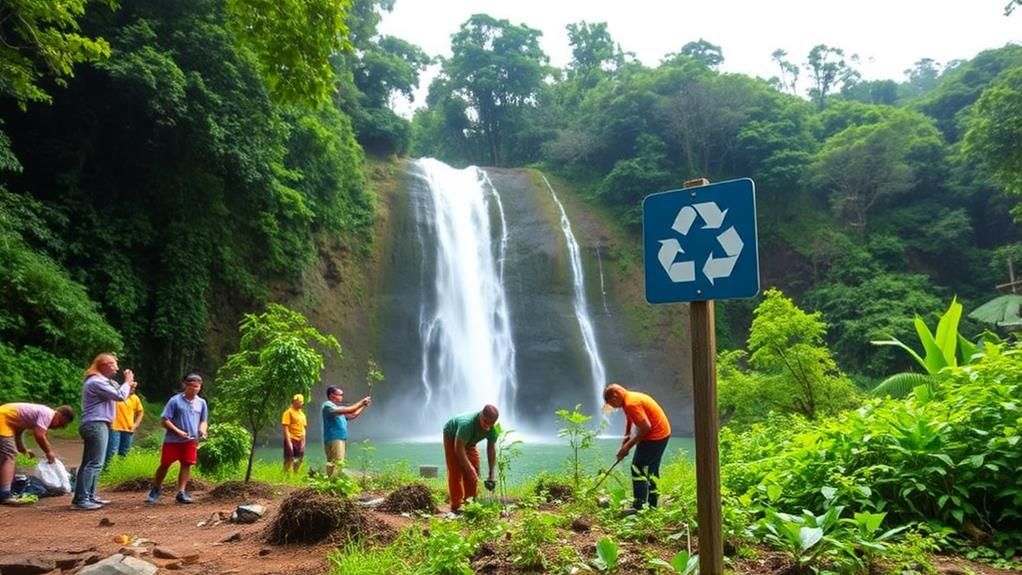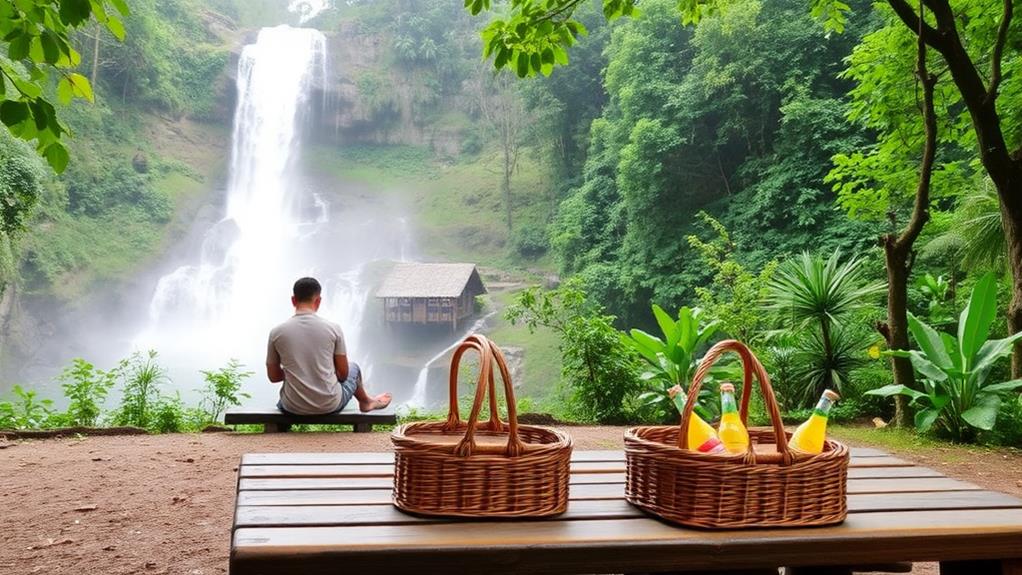Hinulugang Taktak: A Historic Waterfall and National Park
Hinulugang Taktak is a historic waterfall and national park in the Philippines that combines natural beauty with cultural significance. The waterfall is located in the city of Antipolo and is considered a popular tourist destination, attracting visitors from all over the country. The park surrounding the waterfall is also home to various species of flora and fauna, making it a great place for nature lovers to explore. In addition to its natural offerings, the Philippines is also known for its diverse marine life and is home to the tubbataha reefs diving paradise, offering a unique underwater experience for diving enthusiasts.
The 21.5-meter tall waterfall is surrounded by lush greenery, making it a unique attraction. The 3.2-hectare park is not only a popular tourist destination but also a site for conservation efforts.
In 1991, it was declared a National Historical Landmark, recognizing its importance in Philippine history. The park has hosted various cultural events and has attracted a large number of visitors, nearly a million in 2018.
Hinulugang Taktak is more than just a waterfall; it's an experience that showcases rich history, diverse flora, and conservation initiatives.
Historical and Cultural Significance

Hinulugang Taktak National Park holds significant cultural and historical importance. The park's name originates from a 15th- or 16th-century legend about a large bell thrown into the falls, which has been woven into the fabric of Philippine culture. This legend is celebrated in the hymn "Antipolo" composed by German San Jose in 1929.
The park has been a recreational site since the Spanish era. It was declared a National Historical Landmark in 1991, emphasizing its historical importance. Over the years, the area has hosted various cultural and social events, showcasing the rich heritage of the region and attracting visitors from afar.
The park's establishment as a national park in 1990 marks its conservation and preservation efforts. This solidifies its cultural significance in the country's history, emphasizing the importance of preserving the park's natural and historical resources for future generations.
Geography and Natural Features
Hinulugang Taktak National Park's geography and natural features are a major attraction. The park is surrounded by lush greenery, showcasing its diverse flora.
Taktak Falls is the park's centerpiece, standing 21.5 meters tall and 25.8 meters wide, making it a breathtaking natural wonder. The waterfall's dimensions are:
| Feature | Description | Measurement |
|---|---|---|
| Waterfall Height | Taktak Falls' vertical drop | 21.5 meters (70.5 feet) |
| Waterfall Width | Taktak Falls' horizontal span | 25.8 meters (84.6 feet) |
The park's elevation is 28.98 kilometers southeast of Manila, with Miocene layers beneath Quaternary soil.
The waterfall's water flow varies, peaking during the rainy season. This seasonal change attracts photographers and nature enthusiasts who come to marvel at the waterfall's power and beauty.
Rehabilitation and Conservation Efforts

Rehabilitation and Conservation Efforts
Initial Restoration Projects
Hinulugang Taktak National Park has undergone significant rehabilitation and conservation efforts since 1991 to restore its natural beauty and ecological integrity.
A budget of 100 million pesos was allocated in 2009 for restoration projects, which aimed to improve the park's facilities and environment.
Intensified Rehabilitation After Oil Spill
An oil spill in 2015 prompted intensified rehabilitation efforts to address pollution and restore wildlife habitats.
The local government actively maintains cleanliness and safety in the area, promoting community engagement in conservation activities to protect the park from pollution and overdevelopment.
Awareness Campaigns and Education
Awareness campaigns have been implemented to educate visitors and local residents about the importance of preserving Hinulugang Taktak's natural environment.
This effort demonstrates the local government's commitment to preserving this national treasure for future generations.
Visitor Statistics and Recreational Activities
Hinulugang Taktak National Park is a popular recreational destination, attracting nearly a million visitors in 2018. The park has consistently drawn large crowds, ranking as the second most visited national park in the Philippines in 2003 and 2004.
By 2008, it had generated 11.1 million pesos in revenue, ranking third among protected areas.
The park offers a range of recreational activities. Visitors can picnic with family and friends, swim in designated safe areas, or hike along available trails.
The park also hosts cultural events and festivals, celebrating local heritage and attracting both local and international tourists.
Governance and Management

Hinulugang Taktak National Park's governance and management involve a collaborative effort among multiple stakeholders. The Department of Environment and Natural Resources (DENR) and the Rizal Provincial Government are the key players in this partnership, working together to ensure effective governance and conservation.
The park's management is based on a co-management agreement with local government units. This agreement aims to enhance local governance and community engagement. Since 2000, Hinulugang Taktak has been a protected landscape, and this collaborative approach has been instrumental in its conservation.
A trust fund was established to support park funding and maintenance initiatives. The Integrated Protected Area Fund System provides financial support for the park's upkeep.
Additionally, private entities collaborate with the park management to improve the visitor experience and facilitate park restoration efforts. This multi-stakeholder approach ensures that Hinulugang Taktak's natural heritage is protected and preserved for future generations.
Environmental Challenges and Threats
Hinulugang Taktak National Park faces significant environmental challenges that threaten its natural beauty and ecological integrity.
Since the 1960s, urbanization has led to increased pollution and waste in the surrounding areas. This pollution is evident in the trash found at the catch basin of the falls, indicating ongoing issues with waste management and community involvement in pollution.
Local residents contribute to pollution in upstream rivers, exacerbating the environmental challenges faced by the falls. Despite rehabilitation efforts, the waters of Hinulugang Taktak remain unsafe for swimming, highlighting the need for continuous environmental education and community engagement.
The natural beauty of the falls is threatened by urban development, necessitating ongoing efforts to protect the area from pollution and overdevelopment.
Addressing these environmental challenges requires a collective effort and commitment to preserving the park's natural resources.
Visitor Experience and Amenities

A Well-Maintained Environment
Hinulugang Taktak National Park provides a clean and well-maintained environment for visitors, thanks to ongoing conservation efforts and community engagement. This ensures a comfortable and accessible experience for all.
Accessibility and Amenities
The park's amenities are designed to cater to visitors of all ages and abilities.
The waterfall is just a short, 5-minute walk from the parking area, making it suitable for families and individuals with mobility issues.
The park offers multiple bathrooms with shower and changing areas, picnic tables for resting, and a well-maintained public pool with strict cleanliness rules.
Accessibility Features
To ensure equal access, an elevator is available for seniors and persons with disabilities, allowing them to easily reach the viewing area without having to navigate the steep stairs leading to the waterfall.
Admission and Rules
Admission to the park is free, but visitors are required to register upon entry.
The park's rules and guidelines are in place to ensure a safe and enjoyable experience for all visitors.
Physical Features and Attractions
Hinulugang Taktak National Park's Physical Features
Hinulugang Taktak National Park boasts stunning natural beauty, with its centerpiece being Hinulugang Taktak Falls, which stands at an impressive 21.5 meters (70.5 feet) high and 25.8 meters (84.6 feet) wide.
The water flow of the falls varies seasonally, with peak flow occurring during the rainy season, making it an ideal spot for photographers.
Recreational Space and Amenities
The park spans 3.2 hectares, providing ample space for recreational activities and scenic views.
Visitors can enjoy a refreshing swim in the well-maintained public swimming pool adjacent to the falls or relax in the picnic facilities and meditation areas.
These amenities are designed to enhance the overall experience, allowing visitors to unwind and appreciate the natural beauty surrounding the falls.
Tourism and Economic Impact

Hinulugang Taktak National Park's Tourism Significance
Hinulugang Taktak National Park is a significant contributor to local tourism, attracting a substantial number of visitors each year with its stunning natural beauty and recreational amenities.
In 2018, the park recorded 843,000 visitors, making it the second most visited national park in the Philippines during that period.
Economic Impact
The influx of tourists has a direct impact on the local economy, generating revenue through activities like picnicking and family gatherings.
By 2008, the park had already generated an income of 11.1 million pesos, ranking it third among protected areas in the Philippines.
The park's ongoing rehabilitation and conservation efforts continue to attract visitors, sustaining local businesses and dining establishments in the area.
Environmental and Cultural Preservation
As you explore Hinulugang Taktak, you're not only contributing to the local economy but also supporting environmental preservation and cultural heritage.
Are Hinulugang Taktak and the Banaue Rice Terraces both UNESCO World Heritage Sites?
Yes, both Hinulugang Taktak and the Banaue Rice Terraces are UNESCO World Heritage Sites. The breathtaking banaue rice terraces manmade wonder is renowned for its stunning landscape and ancient agricultural engineering, while Hinulugang Taktak is lauded for its cultural and historical significance in the Philippines.
Conservation Status and Future Plans
Hinulugang Taktak National Park's conservation status is a top priority. The park has been undergoing rehabilitation efforts since 1991, with a significant boost in 2009 when 100 million pesos were allocated for restoration projects.
Despite a temporary closure in 2015 due to an oil spill, this incident led to intensified rehabilitation initiatives and community engagement in conservation activities.
The park's conservation significance is emphasized as a protected landscape since 2000. Local government involvement ensures the park's cleanliness and safety, while awareness campaigns protect the area from pollution and overdevelopment.
For instance, local authorities regularly conduct clean-up drives and implement waste management systems to maintain the park's cleanliness.
Collaboration is essential for park restoration efforts and improving visitor experiences. Continued partnership with private entities and local government units is necessary to enhance conservation initiatives and provide better facilities for visitors.
This includes upgrading infrastructure, such as trails and amenities, to ensure a safe and enjoyable experience for all visitors.
The park's natural beauty will be preserved for generations to come. With ongoing conservation efforts and community engagement, Hinulugang Taktak National Park's natural wonders will be protected and preserved for future generations to appreciate and enjoy.
Frequently Asked Questions
Why Is Hinulugang Taktak Famous?
Hinulugang Taktak is famous due to its rich history and cultural heritage. This significance dates back to the 16th century, when a church bell was thrown into the waterfall, making it a symbol of local folklore.
As a National Historical Landmark, it attracts visitors from all over with its picturesque scenery and refreshing atmosphere.
The waterfall is more than just a natural wonder – it's a cultural icon deeply rooted in the region's history.
What Is the Hinulugang Taktak Myth?
The Hinulugang Taktak myth dates back to the 15th or 16th century. This legend tells the story of a local priest who threw a large bell into the waterfall.
The myth symbolizes the connection between the waterfall and local spirituality, which is deeply rooted in local folklore. In fact, the legend has become an integral part of the region's cultural heritage.
For example, it inspired a popular hymn in 1929. The myth adds to the allure of this breathtaking waterfall, making it a fascinating story worth exploring.
How Much Is the Entrance Fee for Hinulugang Taktak 2024?
The entrance fee for Hinulugang Taktak as of 2024 is Php30 for local visitors and Php100 for foreign visitors.
Children and senior citizens are exempt from paying the entrance fee.
The park operates during daytime hours only, so visitors should plan their trip accordingly.
The entrance fee is used for park maintenance and rehabilitation.
It's essential to check for updates on public access and fees, particularly during peak seasons or special events, to ensure a smooth and enjoyable visit.
Can You Swim in Hinulugang Taktak?
Swimming in Hinulugang Taktak isn't recommended due to questionable water quality. The water in some areas may have a foul odor, making it unsafe for swimming.
To ensure visitor safety, park regulations restrict swimming to designated areas that are monitored by lifeguards. Only swim in designated areas with lifeguards present.
Alternatively, a well-maintained public pool is available as a safer option.
Check recent reviews and updates on water conditions before planning to swim to make an informed decision.